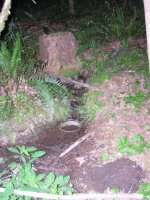CliffordK
Veteran Member
- Joined
- Mar 8, 2013
- Messages
- 2,111
- Location
- Eugene, Oregon
- Tractor
- Toro D200, Ford 1715, International 884,
I've been thinking about trying to develop a small spring for watering my yard and garden.


The spring seems to run year-around, and as far as I can tell, the flow seems to be pretty constant at about a half to one GPM. The hill behind my property isn't a very big hill, so I would be leery about trying to get more water than it naturally provides.
The goal is water for the garden. I haven't tried to test the purity of the water (bacteria?)
It isn't a lot of water, but on a 24 hour basis, it would add up to about 1000 gallons which should be a good portion of my yard usage.
The spring comes right out from under an old fir tree stump.
I put the bucket in a year ago so deer and wildlife would have someplace to drink, although there probably were enough pools for them to drink anyway. Other than leaves falling into it, I noticed that my bucket had silted up this spring.
I'd like to run plastic pipe, perhaps 400 feet total, and less than 50 foot rise (I think) to the highest place on my property where I'll put a 500+ Gallon tank.
It should be about 10 feet above most of what will be using it. I guess I could elevate the tank somewhat too.
I'm thinking about a small, 12V or 24V pump, solar/battery powered.
My well is about 200 feet deep, and I can definitely see the charges on my power bill when I'm watering heavily, so I was hoping this would help a bit. Plus being "renewable".
=============================
Q's & Thoughts?
Can I install a surface tank from which I would pull the water, or do I need to go with digging out the actual spring, and dumping in a load of gravel & etc? Do I risk the gravel also silting up? Damaging the spring?
What size of hose to run for maximum flow with minimum energy (for about 1GPM)? 3/4"?
For a surface tank collection tank, I would be able to just scoop it out every once in a while (or could I convince silt to drain out a drain hole?
Summers are dry here. I might be able to store some rain water, depending on the storage tank size, but I wouldn't expect to get a lot of new rain water after mid June. In fact, perhaps it would be best to assume that a large storage tank could just slowly be filled with spring water during the rainy season rather than trying to capture both rain water and spring water.


The spring seems to run year-around, and as far as I can tell, the flow seems to be pretty constant at about a half to one GPM. The hill behind my property isn't a very big hill, so I would be leery about trying to get more water than it naturally provides.
The goal is water for the garden. I haven't tried to test the purity of the water (bacteria?)
It isn't a lot of water, but on a 24 hour basis, it would add up to about 1000 gallons which should be a good portion of my yard usage.
The spring comes right out from under an old fir tree stump.
I put the bucket in a year ago so deer and wildlife would have someplace to drink, although there probably were enough pools for them to drink anyway. Other than leaves falling into it, I noticed that my bucket had silted up this spring.
I'd like to run plastic pipe, perhaps 400 feet total, and less than 50 foot rise (I think) to the highest place on my property where I'll put a 500+ Gallon tank.
It should be about 10 feet above most of what will be using it. I guess I could elevate the tank somewhat too.
I'm thinking about a small, 12V or 24V pump, solar/battery powered.
My well is about 200 feet deep, and I can definitely see the charges on my power bill when I'm watering heavily, so I was hoping this would help a bit. Plus being "renewable".
=============================
Q's & Thoughts?
Can I install a surface tank from which I would pull the water, or do I need to go with digging out the actual spring, and dumping in a load of gravel & etc? Do I risk the gravel also silting up? Damaging the spring?
What size of hose to run for maximum flow with minimum energy (for about 1GPM)? 3/4"?
For a surface tank collection tank, I would be able to just scoop it out every once in a while (or could I convince silt to drain out a drain hole?
Summers are dry here. I might be able to store some rain water, depending on the storage tank size, but I wouldn't expect to get a lot of new rain water after mid June. In fact, perhaps it would be best to assume that a large storage tank could just slowly be filled with spring water during the rainy season rather than trying to capture both rain water and spring water.
